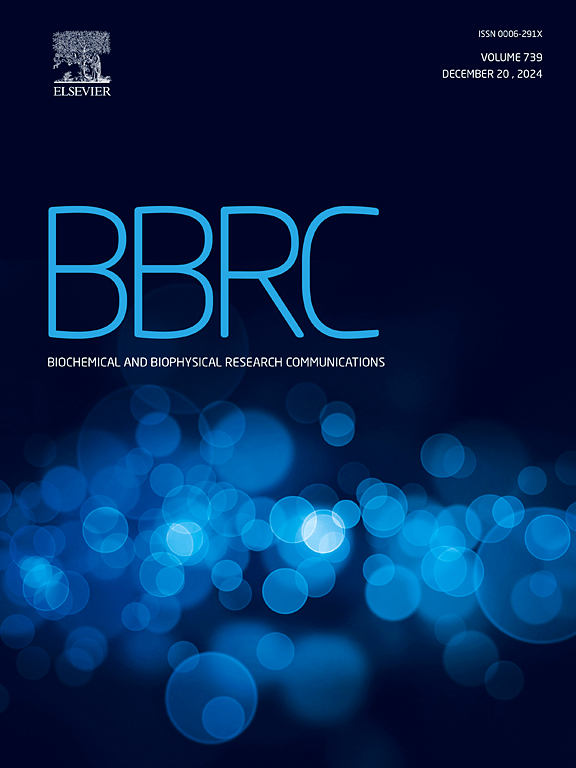Loss of DNA replication fork protection by TIMELESS degradation supports oncogene-induced senescence
IF 2.5
3区 生物学
Q3 BIOCHEMISTRY & MOLECULAR BIOLOGY
Biochemical and biophysical research communications
Pub Date : 2025-06-12
DOI:10.1016/j.bbrc.2025.152203
引用次数: 0
Abstract
Oncogene-induced senescence (OIS) is a potent barrier that limits tumorigenesis. While persistent DNA replication stress accompanied by cellular hyperproliferation is considered an underlying basis of OIS, the molecular mechanisms through which oncogenes elicit genome instability remain unclear. Here, we identify a distinct cellular process in which DNA replication fork stalling is linked to senescence in response to oncogenic signaling. We demonstrate that TIMELESS (TIM), an essential regulatory component of the fork protection complex that supports the integrity of the replisome, is downregulated in non-transformed human cell lines that undergo OIS by HRASG12V expression. Loss of TIM is sufficient to induce senescence, while ectopic expression of TIM delays the induction of OIS via enhancing protection of stalled forks. Furthermore, TIM levels are restored in cells capable of bypassing OIS, indicating that TIM regulation modulates the onset of OIS. Mechanistically, HRASG12V expression induces cellular poly(ADP-ribosyl)ation mediated by PARP1, which prompts poly(ADP-ribose)/PAR-dependent TIM degradation. Together, our study uncovers RAS-mediated proteolytic signaling as a key determinant of OIS centered at stalled DNA replication forks. We propose the existence of an oncogenic signaling cascade that actively suppresses replisome activity, contributing to the DNA replication stress that drives OIS.
DNA复制叉保护的丧失由TIMELESS降解支持癌基因诱导的衰老
癌基因诱导衰老(OIS)是限制肿瘤发生的有效屏障。虽然持续的DNA复制压力伴随细胞过度增殖被认为是OIS的潜在基础,但致癌基因引发基因组不稳定的分子机制尚不清楚。在这里,我们确定了一个独特的细胞过程,在这个过程中,DNA复制叉的停滞与衰老有关,以响应致癌信号。我们证明,支持复制体完整性的叉保护复合体的重要调控成分TIMELESS (TIM)在通过HRASG12V表达OIS的非转化人类细胞系中下调。TIM的缺失足以诱导衰老,而TIM的异位表达通过增强对停滞分叉的保护来延缓OIS的诱导。此外,TIM水平在能够绕过OIS的细胞中恢复,表明TIM调节OIS的发生。从机制上讲,HRASG12V表达诱导PARP1介导的细胞多聚(adp -核糖)化,从而促进多聚(adp -核糖)/ par依赖性TIM降解。总之,我们的研究揭示了ras介导的蛋白水解信号是位于停滞DNA复制分叉处的OIS的关键决定因素。我们提出了一个致癌信号级联的存在,该级联积极地抑制了复制体的活性,促进了驱动OIS的DNA复制应激。
本文章由计算机程序翻译,如有差异,请以英文原文为准。
求助全文
约1分钟内获得全文
求助全文
来源期刊
CiteScore
6.10
自引率
0.00%
发文量
1400
审稿时长
14 days
期刊介绍:
Biochemical and Biophysical Research Communications is the premier international journal devoted to the very rapid dissemination of timely and significant experimental results in diverse fields of biological research. The development of the "Breakthroughs and Views" section brings the minireview format to the journal, and issues often contain collections of special interest manuscripts. BBRC is published weekly (52 issues/year).Research Areas now include: Biochemistry; biophysics; cell biology; developmental biology; immunology
; molecular biology; neurobiology; plant biology and proteomics

 求助内容:
求助内容: 应助结果提醒方式:
应助结果提醒方式:


